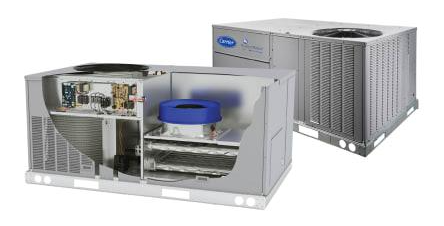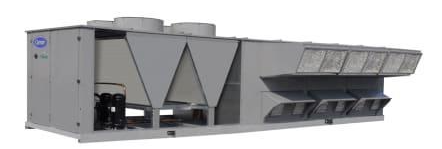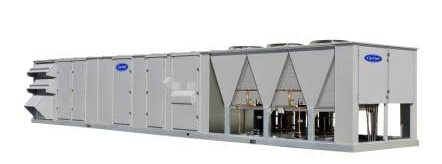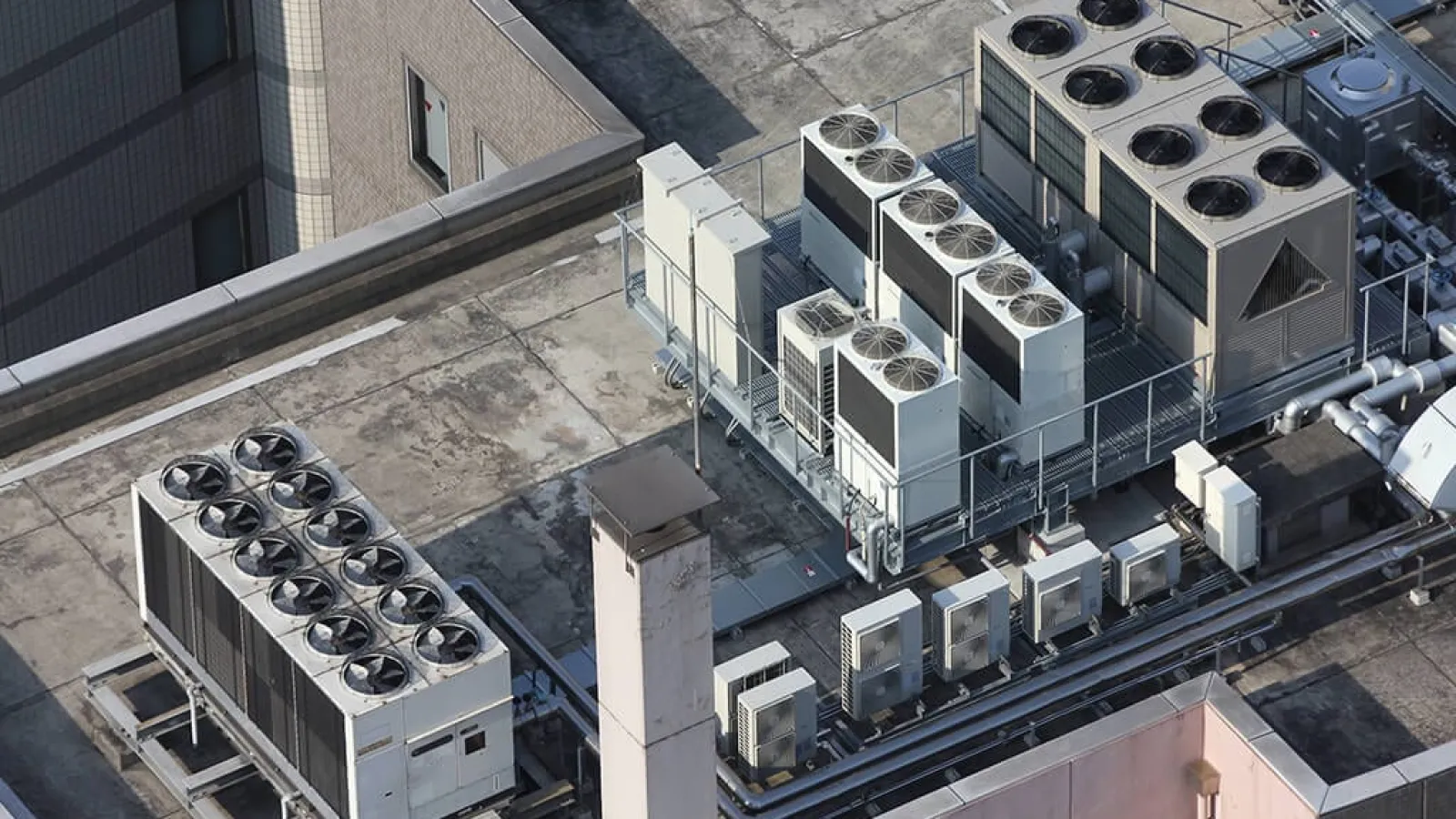How Rooftop AC Unit Works
Are you a facility manager or HVAC professional looking to learn more about how rooftop AC units work? Rooftop AC units serve as the cooling powerhouse for medium to large-sized buildings around the country and the world.
If your building fits this description, it's important to understand your complete options, as well as the advancements in system-specific technologies and capacity ranges for potential commercial HVAC replacement.
That's why, in this article, we will share with you how rooftop AC units work; where they are used; and some of the types of systems available. Let's get started.
What is a rooftop AC unit?
Rooftop units, or commercial packaged outdoor units, provide cooling, heating, and ventilation to light commercial and industrial buildings.
These units are commonly used in commercial buildings, such as shopping malls, food retail, warehouses, and schools. Depending on your building, its size, and location, rooftop units can be installed on the rooftop or on-ground.
The term "packaged unit," which is used to also refer to "rooftop AC units," gets its name from the mechanical design of these systems. The components are housed together in one unit, making it easy for technicians to install, service, and conduct routine maintenance on the system.
Depending on the square footage of your facility, manufacturers like Carrier offer units with the necessary capacity ranges for your facility's cooling capacity. Their commercial units range from 3 tons to 100 tons. See the "Systems Offered by Carrier" section below for more information.
How does a rooftop AC unit work?
With its components packaged together to fulfill occupancy comfort throughout all seasons of the year, a rooftop AC distributes conditioned air, and heats air, depending on the unit, throughout a defined area using ductwork.
Rooftop units are able to heat your space by using a gas-fired heater or electric heat pump. The process of how rooftop AC units work is described below.
Inside the rooftop unit contains various dampers to control the airflow going through the system, filters to filter the outside air, evaporator, and condenser coils to cool the air, as well as one central fan.
The central fan brings air from outside the building through dampers and filters to remove any dust and debris before its temperature is adjusted in the heat exchanger. It also helps to move air to the return register or outside of the building.
Within the heat exchanger, it's important to note that rooftop units have their own refrigeration system to allow you to control the temperature of the air. Once the air is conditioned after exiting the heat exchanger, the fan pushes the air out into the space.
A separate duct, the return air duct, will collect the warm air from the room and distribute it back to the rooftop unit, either out in the atmosphere or recirculated back into the space, depending on the conditions of the room and environment.
If the inside air matches the atmospheric temperature, these units will typically draw in outside air, reducing cooling demands and increasing efficiency. Now that we briefly covered how a rooftop AC unit works, we will now discuss where these units can be used.
Where is a rooftop AC unit used?
The size of a rooftop air conditioner is measured by its cooling capacity, which will help determine if the air conditioner is appropriate for your space.
Cooling capacity is a measurement of the air conditioner's ability to remove heat from your space over an hour's time. It's measured in British Thermal Units per Hour (BTUh) or tons. One ton of cooling capacity is equal to 12,000 BTUs per hour.
Depending on your space, square footage, and occupancy level, the tonnage of the unit is important when choosing the best unit for your commercial space. The typical light commercial air conditioner exceeds 5 tons and above.
Carrier offers a full suite of commercial rooftop air conditioning units ranging from 3 to 5 tons for smaller spaces to 6 to 25 tons for light commercial, and up to 100 tons for heavy commercial. To best determine the cooling capacity, you will need to calculate the cooling load.
This can be done when you consult with a licensed and expert commercial HVAC technician. Determining the amount of heat needed to remove from the space over an hour's time is typically assessed and calculated to ensure the system ratings meet the comfort needs of occupants.
Assessing your space based on its cooling load calculation will help facilitate the proper sizing of the HVAC system to your space, its equipment selection, and the ductwork design necessary to deliver the conditioned air to the space.
Carrier Rooftop Packaged Units
Carrier offers a complete line-up of commercial rooftop packaged units, and the unit best for you will depend on your building's unique needs and capacity requirements. You will want to pay attention to energy efficiency ratings, capacity ranges, and applications.
Starting with lower capacity units and up, the following are some of Carrier's latest commercial packaged rooftop units lineup:

WeatherMaker Single-Packaged Rooftop Units with EcoBlue Technology 48FC
Gas heating and electric cooling
3 to 6 Nominal Tons, best for smaller buildings or commercial spaces
Efficiency (EER/SEER): 14.0, 15.0
Unit features Carrier's latest EcoBlue Technology to improve performance and efficiency while decreasing maintenance and installation costs.

WeatherMaker Single Packaged Rooftop Units 48A
Gas heating and electric cooling with Puron
20 to 60 Nominal Tons, best for medium- to heavy-commercial applications
Efficiency (EER/SEER): 10.3, 14.0
R-410A Refrigerant

WeatherMaker Single Packaged Rooftop Units 50P
Gas heating and electric cooling with Puron (R-410A Refrigerant)
30 to 100 Nominal Tons, best used for warehouse facility, industrial plants, emergency backup cooling, and factories
Efficiency (EER/SEER): 10.9, 10.9
This is a brief overview of Carrier's Commerical Packaged Outdoor Rooftop Units. If you have any questions or would like additional information, please contact our team today. At Estes Services, we are a proud partner of Carrier for commercial HVAC replacement.
Schedule Commercial HVAC Consultation Today
That explains how a rooftop AC unit works. Whether you're looking to repair your existing rooftop AC unit or considering a replacement to one, we are here to help.
Leave it to the commercial HVAC experts at Estes Services for all your rooftop AC unit needs. Since 1949, we have been a locally-owned and operated family business proudly serving the greater Atlanta area.
We pride ourselves in delivering expert advice, top-quality service, and excellent customer satisfaction. Schedule commercial HVAC service with us today. It's that Easy; It's Estes!

